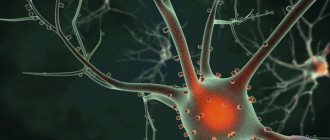VSD is a common set of symptoms that in our time has affected not only adults, but also children. There are many causes for this disease, and therefore each clinical case has its own individual characteristics and many approaches to treatment. A common symptom – surges in blood pressure – also cannot be called constant and unambiguous. Pressure during VSD can either increase or decrease, leaving the diagnosis legitimate. With this disease, it is important to understand that “blood pressure instability” is a symptom that disarms the patient in the face of many life-threatening situations.
Over many years of observing, diagnosing and treating patients, specialists at the Yusupov Hospital have proven their ability to help patients solve their problems, improve their quality of life, and move from “tolerate” to “overcome.” Doctors at the Yusupov Hospital will help determine possible causes and select medications that will help a specific patient and in a specific clinical situation.
High blood pressure - causes and symptoms
An increase in blood pressure is most often a reaction of the human body to an irritant (stress, hormonal changes, climate change, etc.). The body, in turn, compensatoryly increases the heart rate, causing the heart to work harder and with greater force. But the opposite situation also happens - when high blood pressure is accompanied by a low heart rate. The reason for this is impaired regulation of the cardiovascular system. With low heart rate and high blood pressure, the brain and heart are primarily affected. Disruption of the blood supply to these organs can threaten the patient's life, so he needs immediate examination and treatment.
Over time, pressure surges become more and more common. This affects a person’s well-being. Symptoms that may bother the patient:
- increased heart rate;
- dizziness;
- headaches of different localization;
- chills or fever;
- short-term visual impairment (“spots”).
These symptoms make a person forget about everything and concentrate only on how he feels, thereby aggravating the situation. When measured with a tonometer, the increase in blood pressure can reach extremely high numbers. At the same time, the headache intensifies, the heartbeat quickens, and the fear of death appears. Despite such poor health, these pressure surges do not carry with them serious consequences. In no more than two hours, the crisis will end with increased urination.
In this case, it is very important to differentiate high blood pressure from a hypertensive crisis, which is dangerous to the health and life of the patient and requires urgent therapeutic measures.
VSD or hypertension?
Sometimes it is difficult to distinguish hypertension from other conditions that are accompanied by increased blood pressure. Therefore, it is important to conduct an examination using hardware and laboratory methods. With hypertension (hypertension), in addition to high blood pressure, characteristic changes will be visible on the cardiogram, thickening of the walls of the left ventricle during ultrasound of the heart, and an increase in the number of red blood cells in the blood during its analysis.
Changes in the condition of internal organs will also occur with hypertension associated with diseases of the thyroid gland, adrenal glands, pituitary gland, heart, and kidneys. Also, some medications can cause persistent or periodic increases in blood pressure.
Increased pressure in vegetative-vascular dystonia is not associated with pathology of internal organs. But without proper treatment, prerequisites for changes in blood vessels and heart may appear. With VSD, the pressure does not rise to alarming levels, but even with an increase of 10 mmHg from normal, the patient’s condition can significantly deteriorate. Patients with true hypertension often do not notice high blood pressure, so they need to monitor their blood pressure three times a day.
Low blood pressure - causes and symptoms
Low blood pressure is also a complication of VSD, causing no less trouble for patients. The patient's body reacts to irritating factors by dilating peripheral vessels, and inhibition dominates in the central nervous system. Patients justify low blood pressure for themselves with all sorts of secondary reasons, without noticing other symptoms.
The most common symptoms of low blood pressure are:
- excessive weakness;
- pathological fatigue;
- increased drowsiness, light sleep itself, frequent nightmares;
- dizziness to the point of fainting;
- impairment of cognitive functions (memory, attention, concentration).
What will help with blood pressure with VSD?
Not every patient with vegetative-vascular dystonia needs blood pressure-lowering medications. If such medications are prescribed, then most likely only to relieve an attack, and only in cases where the tonometer readings are really high.
Patients with VSD who suffer from pressure changes should follow a gentle work regimen, not be overloaded emotionally, and limit the amount of alcohol.
Regular intake of the amino acid glycine will help reduce the excitability of the sympathoadrenal system. But in order to gradually establish normal regulation of all autonomic functions and prevent further pressure surges, it is necessary to take glycine in combination with cystine and glutamic acid. The most effective for VSD in this case will be the complex Eltacin® (glycine + cystine + glutamic acid) and Glycine. Both of these drugs will gradually eliminate the very cause of pressure changes in people with dystonia, and not just temporarily relieve symptoms.
Treatment of manifestations of VSD in Moscow
Due to the fact that VSD brings a lot of discomfort to the patient’s life, most begin to self-medicate. Pressure surges are so unstable and inconsistent that patients take several drugs from different groups that block each other’s action.
Treatment of VSD should begin only when the organic nature of the symptoms is excluded, because many diseases of the cardiovascular and endocrine systems, allergies, focal infections, etc. have a similar clinical picture.
VSD therapy is complex:
- lifestyle modification: proper nutrition, daily routine, stress management (possibly consulting a psychologist);
- attracting specialists from various fields (gastroenterologists, endocrinologists, cardiologists, neurologists, etc.);
- drug treatment aimed at relieving autonomic disorders of VSD (Concor, Paxil, Teraligen);
- physiotherapeutic methods of treatment.
Due to constant anxiety, fear of attacks, drowsiness and disturbed sleep, patients cannot cope with this on their own. The prescribed drug "Paxil" successfully copes with its task - sleep improves, patients get rid of panic attacks, and anxiety goes away. An important feature of Paxil is its ability not to affect blood pressure, which allows it to be used in patients with both hyper- and hypotension.
For mild disorders, if treatment was started in a timely manner, Teraligen performed excellently. It has a mild sedative effect and begins to act almost immediately after administration. It is also important that the drug potentiates the effect of other drugs, so it has to be taken in small dosages, and patients really like this.
For patients with the hypertensive type of VSD, our specialists successfully prescribed the drug Concor, which blocks signals that stimulate the heart, to patients at the Yusupov Hospital.
Concor for VSD reduces the heart rate, normalizes heart rhythm, helping to reduce the heart's need for oxygen. Concor for VSD helps to reduce activity in the sympathetic department of the autonomic nervous system and acts directly on the heart muscle. Concor is a drug that has proven itself to normalize heart contractions in the presence of VSD. The dose of the drug is selected and adjusted only by the doctor.
Patients of the Yusupov Hospital note a quick and long-lasting effect, and if the dosage prescribed by our specialists was followed, no side effects were observed.
“Anaprilin” has also proven itself well for the treatment of VSD. Although this drug is non-selective and acts not only on cardiac receptors, it is the drug of choice when an immediate effect is needed. By reducing the strength and frequency of heart contractions and blocking the action of hormones, it reduces the heart's need for oxygen. Under the influence of anaprilin, blood pressure decreases during VSD. Patients note the advantage of Anaprilin for VSD in that it works quickly, and this is a priority.
Paying attention to the mechanism of increased pressure during VSD, it would be logical to talk about “Enap” in this article. The drug prevents the narrowing of the arteries, preventing the development of hypertension and preventing an increase in pressure during stress or the action of a reflex mechanism. This drug has shown a good effect in patients with frequent panic attacks, since under the influence of the drug the receptors become immune to adrenaline, which makes it possible to break the vicious circle and cope with the symptoms of VSD.
What leads to disruption of the autonomic nervous system?
A confirmed diagnosis of vegetative-vascular dystonia indicates a malfunction of the nervous system with autonomic manifestations.
The functioning of the ANS is disrupted by the following factors:
- hereditary predisposition of the body;
- presence of psychosomatic and neurological diseases;
- disruptions in the functioning of the endocrine system;
- hormonal imbalance;
- characteristics of the mental state (isolation, low self-esteem, constant worries for no specific reason);
- brain injuries;
- allergic reactions;
- alcohol abuse;
- prolonged depression or chronic stress;
- neurosis of varying severity.
Treatment of manifestations of VSD in Moscow
Medicine has always developed dynamically, and at the moment there is a whole host of effective treatment methods. The specialists of the Yusupov Hospital, using their accumulated knowledge and skills, never cease to absorb new knowledge. There is no panacea for all diseases, but this is not a reason to be alone with your problems. The clinic’s doctors find an individual approach, select the treatment necessary in a particular case, provide comfortable conditions, and help where your body could not cope. Don’t put up with the symptoms - make an appointment by calling the Yusupov Hospital.
Is your blood pressure going up?
To make a diagnosis and provide the necessary assistance, a neurologist will listen to your complaints, conduct an examination and a comprehensive neurological examination, which includes:
- collection of anamnesis of the disease (conversation);
- special neurological tests;
- reflex diagnostics;
- local palpation examination of the spine and musculoskeletal system.
In addition to the main examination, if necessary, the doctor may prescribe:
- MRI;
- Ultrasound;
- X-ray;
- Lab tests;
- EEG;
Complications
Vegetative-vascular dystonia sometimes leads to the most dangerous exacerbations and complications. The development of vegetative crises is possible, observed in half of the cases. Depending on the part of the autonomic system that is affected, crises can be vagoinsular, sympathoadrenal, or mixed.
A sympathoadrenal crisis is called a panic attack. This condition is accompanied by a sharp release of adrenaline in the blood. The abnormal process occurs under the influence of the autonomic system. As the disorder develops, the patient experiences a sharp headache and increased heart rate. Symptoms of cardialgia may appear. The face turns red or pale.
Vegetative-vascular dystonia is accompanied by the appearance of symptoms of arterial hypertension, increased heart rate, increased temperature to subfebrile levels, chills, loss of sensation in the limbs, a feeling of severe anxiety and fear, which is taken into account in the diagnosis. The crisis ends as suddenly as it begins and lasts for a short period. After its completion, asthenia develops, polyuria occurs, accompanied by the release of urine of low specific gravity.
Vagoinsular crisis is characterized by criteria opposite to sympathetic effects. In this state, there is a release of insulin in the blood, the glucose level drops sharply, and the activity of the digestive organs increases.
A person’s heart stops, arrhythmia develops, dizziness develops, breathing becomes impaired, a feeling of lack of air appears, the pulse slows down, and blood pressure drops. Symptoms of increased sweating, redness of the skin, general weakness, and darkening of the eyes appear.
The crisis is characterized by increased intestinal motility, causing flatulence, diarrhea, and rumbling in the abdomen. After the end of the attack, pronounced post-crisis asthenia is observed. In most cases, mixed types of crises appear, both parts of the autonomic system are activated.
Treatment options
Vegetative-vascular dystonia requires an individual approach to the selection of modern diagnostics and a set of therapeutic measures. When choosing methods for treating VSD, the therapist takes into account the form of the disease, the frequency of attacks, the age of the patient, and the presence of additional pathologies. According to healthcare policy, a citizen independently addresses questions of interest to a medical institution under a compulsory medical insurance policy or for paid services; information about them and contacts of specialists are on the clinics’ websites.
The treatment described in many educational articles is aimed at eliminating the signals of the disorder and influencing the causes of its occurrence. Of no small importance in VSD is the improvement of the patient’s psycho-emotional state. Periodic nervous overstrain and stress do not improve the condition.
Vascular dystonia requires an integrated approach to therapy. For the treatment of VSD, sufficient measures are:
- taking medications;
- normalization of lifestyle;
- spa treatment (beneficial for general health);
- psychotherapy.
Treatment of vegetative-vascular dystonia is indicated using manual therapy. Proper treatment of the spine helps to normalize work capacity. The spinal cord contains autonomic centers that are affected during the development of spinal diseases.
It is important to treat protrusions, scoliosis, intervertebral hernias, spondylosis, and osteochondrosis. If you make an appointment with a doctor at the initial stage of the disease, you will be able to completely eliminate the causes of VSD.
Drug therapy
Treatment of VSD in patients is carried out by taking medications; they are prescribed by a neurologist after an in-depth diagnosis. He selects the course of drugs on an individual basis (taking into account tolerability and the presence of side effects). For the treatment of vegetative-vascular dystonia, the following medications are prescribed:
- Antidepressants (sedatives) – provide a reduction in increased anxiety and severe irritability. By taking such drugs, it is possible to relieve constant pain in the heart and muscles.
- Tranquilizers - medications reduce the likelihood of panic attacks and unreasonable fears.
- Sedatives - herbal remedies; if they do not help, the most serious drugs are used.
- Nootropic drugs – stimulate blood circulation in the vessels of the brain, eliminate the negative effects of hypoxia, and have a positive effect on the body’s resistance to stress.
- Adrenergic blockers - used to eliminate disruptions in the heart rhythm.
- Diuretics – used for headaches and dizziness associated with high intracranial pressure and hypertension. They have the ability to remove fluid from the body. Diuretics reduce the level of vitamins and microelements.
- B vitamins normalize the conduction of nerve impulses during VSD. They improve the activity of the central nervous system.
- Metabolic agents - help control glucose parameters during sympathetic VSD. They are characterized by antihypoxic and microcircular characteristics.
Lifestyle change
To improve the functioning of the autonomic system, people with this diagnosis should make adjustments to their lifestyle and habits. With the development of vegetative-vascular dystonia, special therapy involves a combination of the following rules:
- Normalize your work and rest schedule, take a contrast shower, relaxing baths, do therapeutic massage, and introduce sports into the practice. To get rid of dystonia, during the working day they do gymnastics, take breaks from work, and take a walk. This helps normalize blood circulation and relax, restore immunity.
- Get enough sleep every day, you need to sleep at least 8 hours.
- You should take a walk in the fresh air every day. The walk lasts at least 1 hour. This has a good effect on the functioning of the whole body.
- Lead a sporty lifestyle. Physical activity is not intense, but moderate.
- Diet restrictions. Foods containing a lot of trans fats are removed from the diet. These substances lead to the appearance of atherosclerotic plaques and increase nervous excitability. You cannot follow strict diets. They negatively affect the psycho-emotional state.
Nutrition
When disorders develop, the diet should be compiled taking into account the principles:
- Eat plenty of foods containing beneficial microelements. They have a beneficial effect on the functioning of the heart and blood vessels, and normalize blood pressure parameters.
- Drink at least 1.5 liters of clean water per day. This will help to significantly normalize the water-salt balance.
- Enjoy food.
- Bring your diet closer to the requirements of a healthy diet.
Features of the diet differ depending on the type of pathology. If a person suffers from hypertension, foods containing a lot of salt should be excluded from the diet. It is important to give up fast food, canned food, and marinades. It is useful to eat soups with vegetable or fish broth. A substitute for wheat bread is baking made from whole grain flour.
With the hypotonic type of the disease, the menu contains vegetables, fruits containing vitamin C, and carotene. It is beneficial to eat foods that help raise blood pressure. Vegetative-vascular dystonia requires the use of foods:
- citrus fruit;
- nuts;
- cheeses;
- black chocolate;
- coffee;
- cocoa;
- bananas.
Cardiac vegetative-vascular type of dystonia involves consuming large amounts of foods containing vitamins. This has a beneficial effect on the functioning of the heart, and there is a decrease in the risk of negative health consequences, which eliminates the need to consult a cardiologist. The diet includes:
- oatmeal;
- buckwheat;
- eggs;
- onion;
- eggplant;
- apricots;
- peaches;
- grape;
- legumes;
- lean types of meat and fish.
Psychotherapy
The disorder requires psychotherapeutic help. Effective treatment helps to target the causes. This allows you to get rid of indicators of vegetative-vascular dystonia. In some cases, consultation with a psychiatrist is required.
Spa treatment
An annual holiday in a sanatorium improves your physical and psycho-emotional state. Thanks to this, it is possible to prolong the state of remission. Traveling abroad is not necessary. You can choose a balneological resort in a comfortable climate zone.









